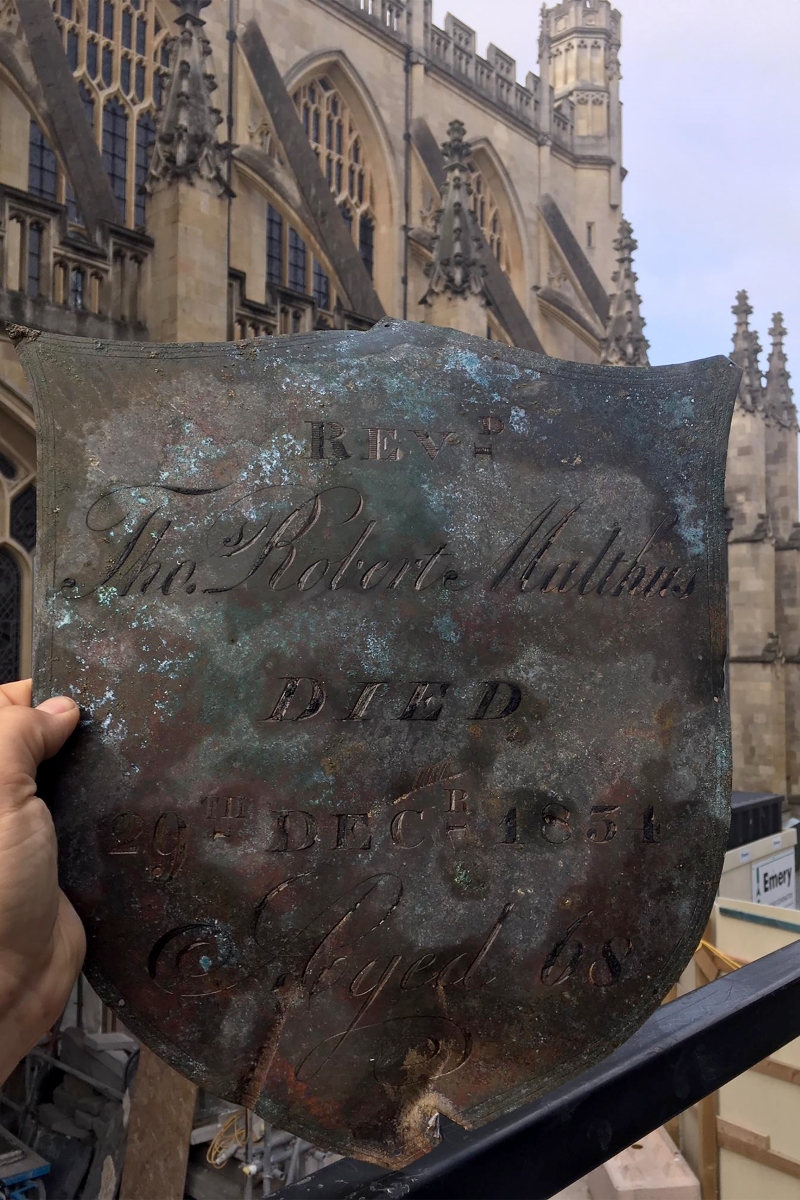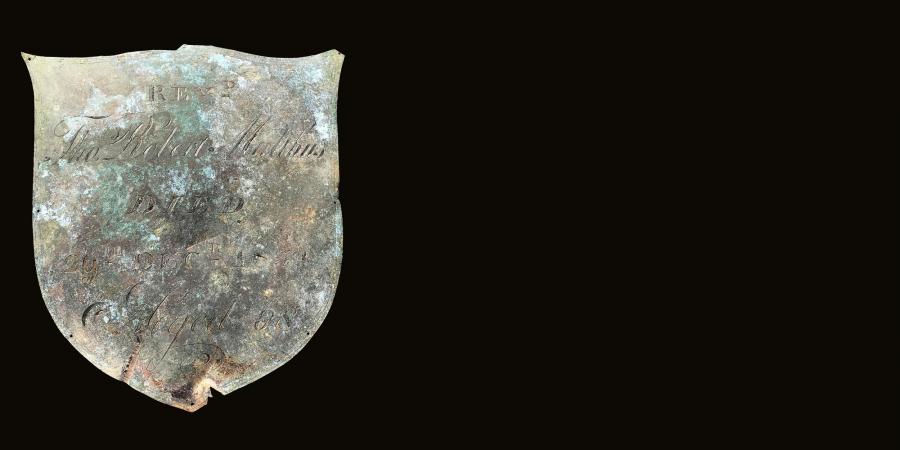Archaeologists at Bath Abbey have found the last resting place of the Rev. Thomas Robert Malthus (1766–1834) – the controversial demographer and political economist whose ideas on population growth, known as Malthusianism, had a major influence on scientific thought and government policy from the early 19th century onwards.
The discovery was made during construction work associated with the Heritage Lottery Fund supported Bath Abbey Footprint Project, the aim of which is to repair the Abbey’s collapsing floor, install a new eco-friendly heating system using Bath’s hot springs, and provide new improved space and facilities for local residents, worshippers and visitors. Between the early 17th and early 19th centuries, approximately 6,000 burials were placed under the Abbey floor, with little consideration as to what would happen when the coffins decayed. The result was that large voids developed, into which the floor has been gradually subsiding. The current repair work entails lifting the ledger stones, for which the Abbey is famous, and excavating the uppermost meter of soil to allow the construction of a new floor and heating system, but as Senior Project Officer Cai Mason explains, this isn’t the first time the floor has been dug up:
"The last major renovation at the Abbey took place in the 1860s under the direction of Sir Gilbert Scott. He was responsible for constructing the beautiful stone fan vaults over the nave, installing a coal-fired heating system under the floor and laying a limecrete slab, which he hoped would be strong enough to support the subsiding floor. Our excavations have shown that the Victorian workmen disturbed many of the shallower graves, and we have found hundreds of jumbled bones mixed in amongst the soil and rubble. These bones are the remains of individuals who were buried in the 18th and 19th centuries. Most are anonymous, but we have been able to identify a small number of individuals from the names on metal coffin plates found with the bones; one of which belonged to the Reverend Malthus."

Thomas Robert Malthus was born In Westcott, Surrey in 1766. As a child, he was bullied for his syndactyly (webbed feet), which sparked an interest in eugenics. He studied English declamation, Latin, Greek and mathematics at Cambridge, then took holy orders in 1789 and was appointed as a curate in Wotton, Surrey. Malthus lived at a time when Britain’s population was expanding at an unprecedented rate, and he first came to prominence following the publication of An Essay on the Principals of Population Growth, which was published anonymously in 1798. This essay outlined the idea that exponential population growth of the ‘lower classes’ would eventually outstrip the growth in food production, leading to a ‘Malthusian Catastrophe’ where there were too many people and not enough food. War, famine and disease would then intervene to restore the ‘natural order’. To avert this catastrophe, Malthus proposed ‘preventive checks’, such as birth control, postponement of marriage, and celibacy. He also advocated the abolition of the poor relief, which he considered to be ‘undermining the independence and resilience of the peasant’ and that it encouraged the poor to have children they were unable to support. Malthus’s ideas had a major influence on scientific and political thought in the 19th and 20th centuries, notably on the development of Charles Darwin and Alfred Russel Wallace’s theory of natural selection. He also influenced government policy, particularly in relation to food relief for the poor and government responses to famines: the latter having disastrous consequences for the 19th-century populations of British-administered India and Ireland. Although many of Malthus’ ideas have since been widely rejected, he continues to have an influence on present day discussions about population growth and its impact on society and the environment.
The disarticulated human remains recovered from inside the Abbey during the repairs to the floor have been carefully removed and stored for the duration of the works. At an appropriate point during the repair work, these will be respectfully reinterred and a special prayer will be said, following an osteoarchaeological assessment. The remains can reveal a wealth of information about Bath’s historic population, as Senior Osteoarchaeologist Kirsten Dinwiddy explains;
"Although we will only be able to assess the remains of a small proportion of the thousands of individuals buried within the Abbey during the post-medieval period, we will still gain valuable insights into their physical lives, what they suffered from and in some cases, how they were treated in death. In so doing we are able to test and enhance our current understanding. Wider benefits include contributions towards the study of the history of medicine as well as the evolution of certain disease and conditions"
Revd Stephen Girling, one of the clergy at Bath Abbey, said;
"Each phase of the Abbey’s Footprint project has brought about some wonderful discoveries by the archaeologists. As we know there was once an Anglo-Saxon monastery and a Norman cathedral on this site, some of the finds have been expected. However, what’s been especially revealing is how the finds have allowed us to learn more about the people connected with the Abbey, many of whom are fascinating characters, such as Thomas Robert Malthus. Regardless of our opinion of Malthus, his ideas were certainly influential; they were hotly debated in his time and continue to be so to this day."

